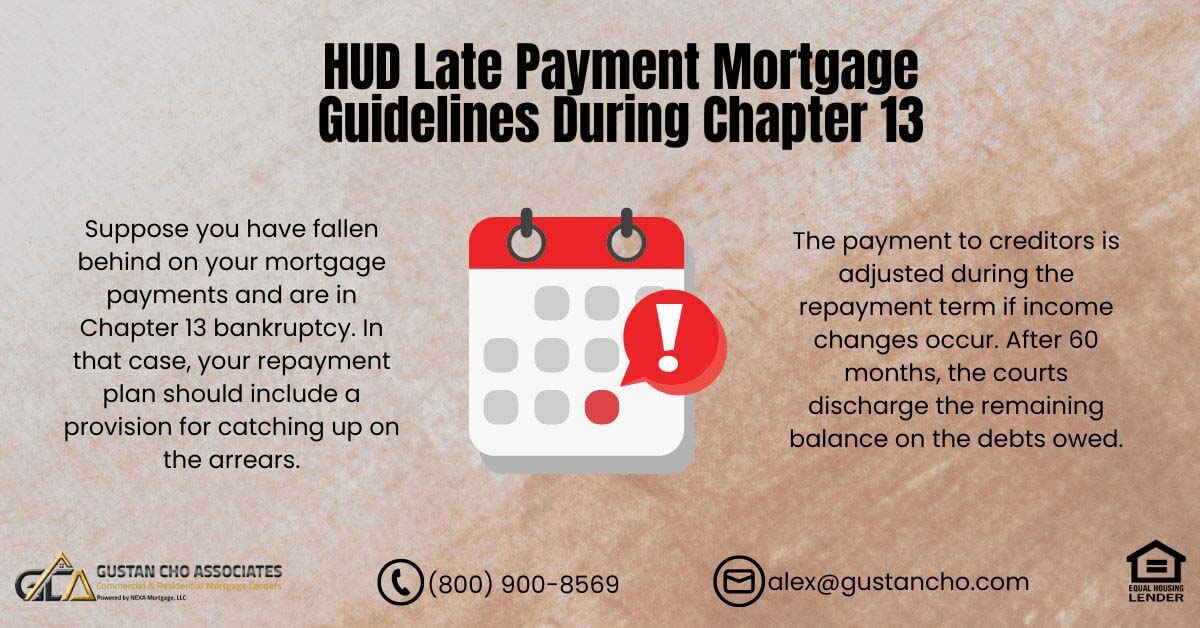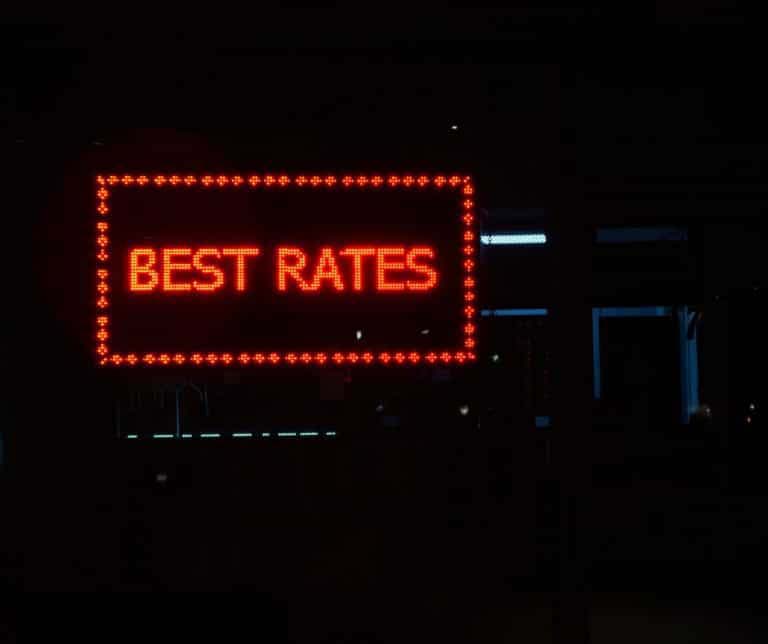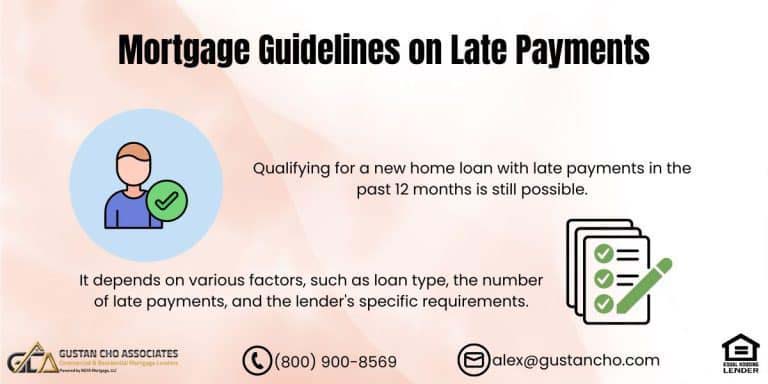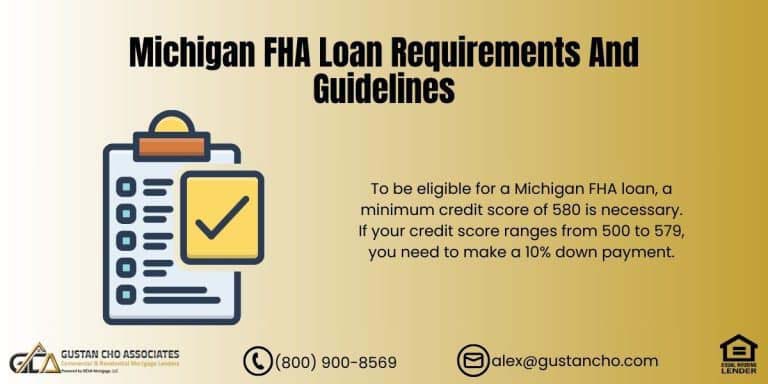This blog will discuss HUD late payment mortgage guidelines during the Chapter 13 Bankruptcy repayment plan. HUD and VA are the only two mortgage loan programs that allow borrowers in an active Chapter 13 Bankruptcy repayment plan to qualify for an FHA and VA loan. However, the key is to have been timely on all their payments during the plan. To be eligible for FHA and VA loans during Chapter 13 Bankruptcy, you normally need timely payments in the past 24 months. HUD late payment mortgage guidelines require 24 months of timely payments. VA loans have more lenient guidelines versus HUD late payment mortgage guidelines and will allow timely payments in the past 24 months on manual underwriting.
HUD Manual Underwriting Guidelines During Chapter 13 Bankruptcy
Chapter 13 bankruptcy allows individuals with a regular income to create a repayment plan to pay off their debts over three to five years. This includes mortgage arrears. Borrowers need to have been timely in the past 24 months on manual underwriting. This holds especially true for timely payments in the past 24 months. It needs to be a manual underwrite because you cannot get approve/eligible on an FHA and VA loan during the Chapter 13 Bankruptcy repayment plan. In this article, we will discuss and cover the HUD late payment mortgage guidelines during the Chapter 13 Bankruptcy repayment plan.
Qualify for FHA and VA Loans after Bankruptcy, click here for free quote
Qualifying For FHA and VA Loans After Bankruptcy
Borrowers can qualify for FHA and VA loans after bankruptcy. There is a two-year waiting period to qualify for FHA and VA loans after Chapter 7 Bankruptcy. Borrowers can qualify for FHA and VA loans during the Chapter 13 Bankruptcy repayment plan without Chapter 13 being discharged. The guidelines for late payment of a mortgage during Chapter 13 bankruptcy are typically determined by the terms of Chapter 13 approved by the bankruptcy court and the policies of the mortgage lender. Here are some general points to consider. Maintaining open communication with your mortgage lender throughout the Chapter 13 bankruptcy process is essential. If you anticipate difficulty making payments, please contact your lender as soon as possible to discuss possible modifications or accommodations.
HUD Chapter 13 Guidelines After Bankruptcy Discharge
There is no waiting period after the Chapter 13 Bankruptcy discharge date to qualify for VA and FHA loans. VA and FHA loans have the exact same Bankruptcy Guidelines. One problem borrowers will encounter when applying for a mortgage after bankruptcy is most lenders will not allow late payments during and after bankruptcy. Any changes to your mortgage payments, including late payment arrangements, may need to be approved by the bankruptcy court. You should consult your bankruptcy attorney to ensure any proposed changes comply with your repayment plan and local bankruptcy rules.
VA and HUD Late Payment Mortgage Guidelines
Under VA and HUD Late Payment Mortgage Guidelines, borrowers can qualify for VA and FHA loans with late payments during or after bankruptcy. Most lenders have overlays were no late payments during and after bankruptcy are allowed. Gustan Cho Associates has helped many borrowers with late payments during and after bankruptcy.
Suppose you have fallen behind on your mortgage payments and are in Chapter 13 bankruptcy. In that case, your repayment plan should include a provision for catching up on the arrears.
This means you must make monthly payments to the bankruptcy trustee, who will be distributed to your creditors, including your lender. It’s crucial to adhere strictly to the repayment plan and make all the required payments on time. Failing to do so can lead to serious consequences, including dismissing your bankruptcy case or foreclosure proceedings by the mortgage lender.
HUD Late Payment Mortgage Guidelines During Chapter 13 Bankruptcy and How To Avoid Late Payments
Consumers with income can file Chapter 13 Bankruptcies. If a consumer does not have a job, they cannot file Chapter 13 and must explore filing Chapter 7 Bankruptcy. Chapter 13 Bankruptcy is a court-supervised repayment plan over 60 months. A percentage of the consumer’s wages is allocated every month by the trustee. That portion of wages is used to pay creditors.
The payment to creditors is adjusted during the repayment term if income changes occur. After 60 months, the courts discharge the remaining balance on the debts owed.
The consumer is then debt-free. Filing for Chapter 13 bankruptcy typically triggers an automatic stay, which prevents creditors, including your mortgage lender, from taking collection actions, including foreclosure, during the bankruptcy process. However, the lender may seek relief from the automatic stay if you fail to make the agreed-upon payments. get connect with our expert for HUD late payment mortgage guidelines, click here and also get help related to avoid late payments
Objections By Creditors on Chapter 13 Bankruptcy Filings

How Long Does It Take To Clear Chapter 13 Bankruptcy?
The creditor will be filing an objection with the courts to advise the arrearage sum that needs to be paid through the Chapter 13 Plan. This also holds true when petitioners change the terms of an auto loan, and the auto finance company does not agree with the rate and balance. Completing your Chapter 13 repayment plan, including catching up on mortgage arrears, is essential to retaining your home. Once the plan is completed, you should continue making regular mortgage payments to your lender to avoid future issues.
How Much Will My Payment Be In Chapter 13 Bankruptcy?
The Bankruptcy Trustee determines how much your payment be in your Chapter 13 Bankruptcy. Your payment for a mortgage needs to be approved by the Bankruptcy Trustee. Again, this is easily fixed and your attorney will get notice of it and make the necessary corrections, or contact you to discuss the possible correction or modification to your plan so that the objection can be resolved. Here is what Chicago Bankruptcy Attorney Vanessa Favia says about Creditors’ Objections:
If you change the terms of a car loan in an impermissible way and your auto lender does not agree with the interest rate, balance of the loan, or value provided for the vehicle in your schedules, your creditor may file an objection.
Filing an objection will necessary so that they are not bound by such negative treatment. The relief requested in the objection often states to not confirm the plan or dismiss the case. The value of your car is important in situations where you obtained the loan more than 910 days before filing your case because under those circumstances, you can lower the amount of the debt to the value of your car. So, if you owe $20,000 on your car loan, the car is only worth $15,000 and you obtained the loan more than 910 days before you filed, you can lower the balance of the loan to $15,000. The remaining $5,000 would be paid at the same percentage as your other unsecured creditors which may be as low as 10%.
Cases Where You Cannot Lower Your Monthly Debt During Chapter 13 Bankruptcy Repayment Plan
Even if you cannot lower the balance of the loan because you purchased the vehicle within the 910 days immediately preceding the filling of your petition, you can almost always lower the interest rate. Moreover, in a Chapter 7 case, you can always “redeem” a vehicle for the fair market value. This generally involves a lump sum payment to the original vehicle lender. Under the situation provided above, if you owe $20,000 and the car is only worth $15,000, you can “redeem” the car for $15,000.
There are lenders that will loan you the money to redeem such vehicles if the condition and mileage of the car meet their requirements.
Usually, however, these loans involve higher interest rates, so the amount of the loan and payments should be balanced with any possible increase in interest rates. My office has a lender that we refer our clients to if they desire to attempt a “redemption” of their vehicle. Whatever the minimum payment due to creditors, that amount needs to be paid timely. For mortgage borrowers to qualify for a mortgage, timely payments are crucial during and after bankruptcy.
VA and HUD Late Payment Mortgage Guidelines on Manual Underwriting
It’s crucial to consult with a qualified bankruptcy attorney who can provide guidance tailored to your specific situation, as bankruptcy laws and mortgage lender policies can vary. Additionally, the guidelines may change over time, so staying informed about the most up-to-date regulations and requirements is essential. There are two types of mortgage guidelines.
- Agency Guidelines
- Lender Overlays
Nothing in VA and HUD Late Payment Mortgage Guidelines states that borrowers cannot have late payments after bankruptcy and foreclosure. All lenders require borrowers to meet minimum agency mortgage guidelines. Lenders can have additional lending requirements called lender overlays. Mortgage overlays are guidelines above and beyond FHA, VA, USDA, Fannie Mae, and Freddie Mac.
Can I Get Approved For an FHA Loan With Late Payments During Chapter 13 Bankruptcy Repayment Plan
Lenders will not approve borrowers with any late payments during and after bankruptcy. They consider borrowers with late payments during and late payments as second offenders. However, Gustan Cho Associates can help borrowers with late payments during and after bankruptcy. All manual underwriting requires timely payments in the past 24 months. However, on manual underwriting, we have approved borrowers with late payments in the past 24 months.
Letter of Explanation For Late Payments During Chapter 13 Bankruptcy Repayment Plan
I need a solid letter of explanation with supporting docs. We have also helped borrowers with late payments after bankruptcy and foreclosure. I am not saying it is easy, but it is not the end of the world. Borrowers who need to qualify for a mortgage with late payments during and after bankruptcy, please contact us at Gustan Cho Associates at 800-900-8569 or text us for a faster response. Or email us at gcho@gustancho.com. We are a national mortgage company licensed in multiple states with no lender overlays on government and conventional loans. We are available seven days a week, evenings, weekends, and holidays. This blog on HUD late payment mortgage guidelines during Chapter 13 Bankruptcy repayment plan was updated on January 15th, 2024.









